Drip campaigns are a game changer in the world of marketing automation.
When you nail them right, they not only save you time but also powerfully engage your audience and improve your results.
Think of a drip campaign as a pre-scheduled, automatically triggered communication route designed to reach your audience at the right time with the right info
Getting a new sign-up? Trigger a welcome series. Seeing a user hover over a product? Push a reminder email. Drip campaigns tap into customer behaviors and preferences, creating personalized, timely communication.
Better engagement, improved customer retention, and effective lead nurturing - these are just a few of the benefits you'll witness when you effectively employ drip campaigns in your marketing automation.
Tending to your audience with tailored, automated messaging is like watering a garden – you get to watch your business-customer relationship grow, blossom, and bear fruit.
Unlocking the power of drip campaigns is all about understanding your audience and crafting the right communication journey.
It's about being there, all along the customer journey, with just the right messages. Drip campaigns, when done right, will revolutionize how you communicate with your market.
What are Drip Campaigns?
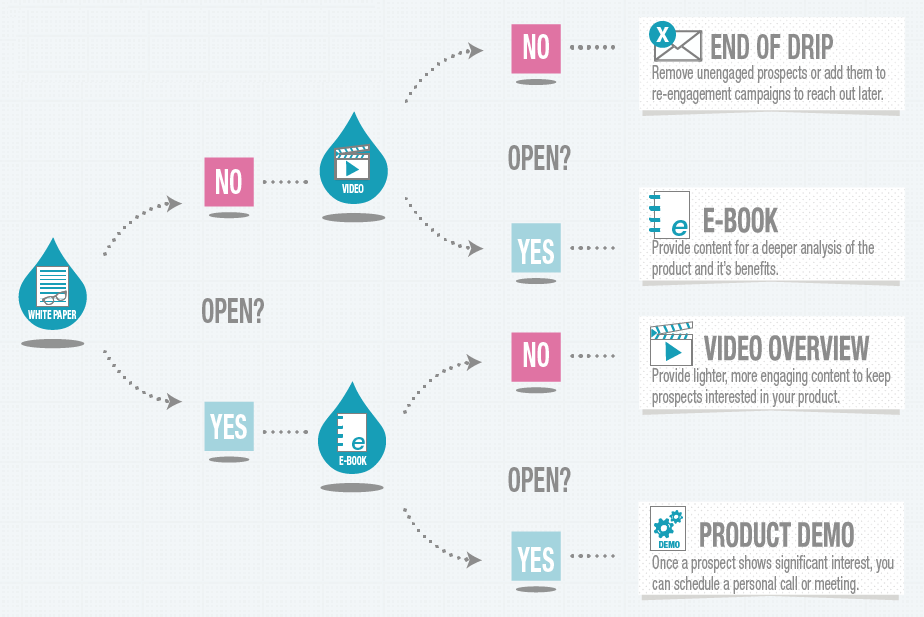
Drip campaigns are a smart marketing strategy that goes above emails.
They contain a sequence of automatic and personalized messages, such as emails, SMS, and even social media updates.
The idea is to gradually develop leads and direct them towards a desired action, hence increasing customer engagement and loyalty.
The Purpose of Drip Campaigns in Marketing Automation
The act of performing repeated marketing chores, including sending emails and posting on social media, is known as marketing automation, and drip campaigns are an important part of it.
Drip campaigns aim to engage users by sending them personalized messages that are customized to their interests and requirements.
Drip campaigns can successfully guide leads toward conversion, retention, and loyalty by gradually providing valuable material.
Different Types of Drip Campaigns
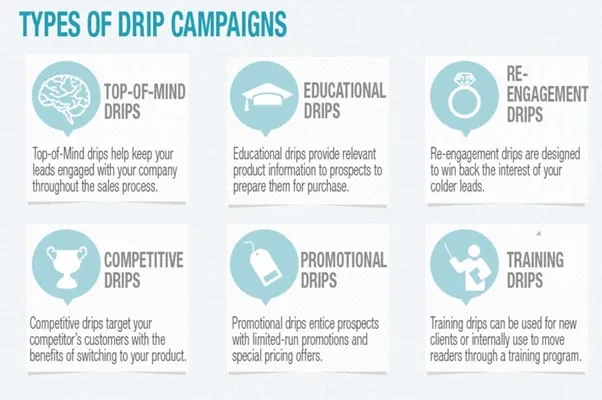
There is a drip campaign for every circumstance, from bringing in new clients to sparking the attention of previous ones.
We'll look at the many kinds and show you how to customize them to meet your unique marketing objectives.
Welcome Series Campaigns: The first point of contact between a company and its prospects or customers is through welcome series marketing.
These ads are meant to welcome new members or clients, present the brand, and highlight the goods and services offered by the business.
Onboarding Campaigns: For SaaS companies to provide the best possible user experience, onboarding programs are important.
The goal of these ads is to walk new customers through the features and capabilities of the product. They also help users set up their accounts, follow best practices, and find resources.
Re-engagement Campaigns: Re-engagement efforts are directed at customers or subscribers who are inactive.
These marketing initiatives attempt to reintroduce lost customers by presenting them with exciting incentives, customized messages and offers that motivate them to act.
Re-engagement programs attempt to boost engagement, keep clients from leaving, and win them back.
Benefits of Using Drip Campaigns in Marketing Automation
Drip campaigns are an exciting development in marketing automation. We'll discuss the benefits of drip programs and how they may improve your marketing approach.
Personalized Communication: Through drip campaigns, companies may send messages that are customized for the interests and behavior of their target audience.
Higher response and engagement rates are a result of this personalized message, which raises conversion rates.
Saves Time and Resources: Businesses may save time and money by automating repetitive marketing processes using drip campaigns.
This frees up marketers from having to send out individual emails and lets them concentrate on developing creative campaigns with relevant content.
Increased ROI: The targeted, individualized, and data-driven nature of drip programs can lead to higher returns on investment.
When designed appropriately, automated campaigns can provide a remarkable return on investment without much work.
Improved Customer Retention: Customer retention can be seriously affected by drip programs since they are designed to develop and motivate leads toward conversion.
Customers' overall happiness increases as a result of the personalized content and message, which creates a feeling of concern and attention and keeps subscribers or customers connected with the business.
Setting up a Drip Campaign
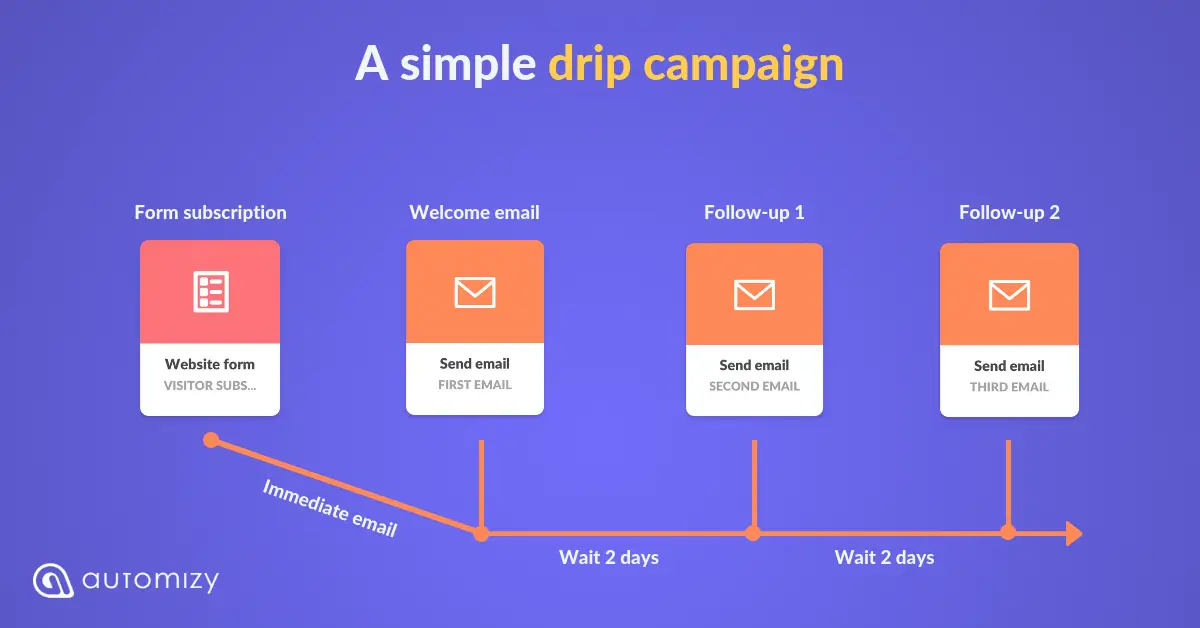
Now that you are aware of the benefits of drip campaigns. We'll guide you through every step of setting up a drip campaign so you can engage your audience and increase conversions.
Defining Goals and Objectives
With this campaign, what goals do you want to accomplish? Are you trying to re-engage inactive customers, promote product use, or cultivate leads?
Establishing clear objectives will enable you to design a targeted drip program that works.
Audience Segmentation
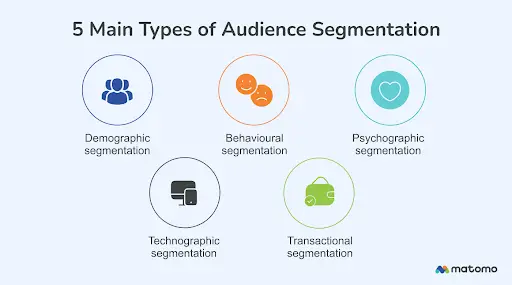
Recognize your audience and their preferences first. Who is who? What bothers them the most?
You may give information that is specifically suited to each part of your audience by breaking them down into groups based on their interests, behaviors, or demographics.
Mapping out the Flow
It's time to plan out the flow of your drip campaign now that you have identified your objectives and separated your target market.
Choose how many emails to send, how long to wait between emails, and what steps you want your readers to take. This process will help you design a campaign that is both organized and compelling.
Welcome Email: The welcome email, which is the first email in your drip campaign, establishes the tone for the whole campaign.
Write a kind and welcoming email that highlights your company, thanks the receiver for their action (such as signing up or buying something), and offers a clear benefit.
Follow-up Emails: The follow-up emails in your drip campaign allow you to gradually nurture your audience by providing valuable content and messages that align with their interests.
Each email should build upon the previous ones and move your audience closer to your desired action.
Call-to-Action Emails: With the help of the follow-up emails in your drip campaign, you can continuously develop your audience by sending them messages and valuable information that are relevant to their interests.
Every email you send out should expand on the one before it and push your reader towards taking the action you want them to.
Crafting Compelling Content
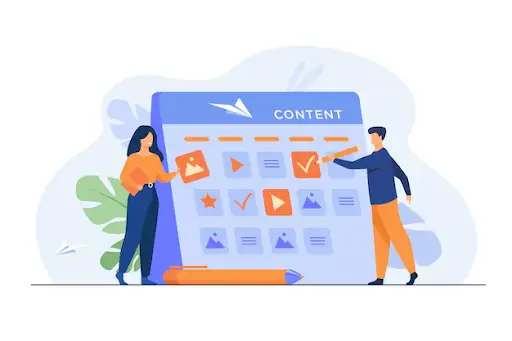
Emails with calls to action are essential to a drip campaign.
A strong call to action should be included in these emails to persuade your readers to complete the intended action, which might be downloading an ebook, making a purchase, or joining a webinar.
To encourage your viewers to convert, make sure your call-to-action is clear and compelling.
Subject Lines and Valuable Content: It's time to create the drip campaign material now that your flow and framework are complete. speak in a conversational, kind, and warm manner. Add a little humor and lightness to keep your audience interested.
Every email in your drip campaign should have meaningful information that informs, entertains, or helps your audience with an issue. Offer advice, market analysis, case studies, or special deals.
Personalization: Customization in drip marketing is innovative. Make them feel like real people by using their first names, mentioning their recent actions or hobbies, and addressing them personally.
Personalization increases interaction and develops a closer bond with your brand.
Suggested Reading:
Chatbots & Marketing Automation – the perfect duo?
Implementing Drip Campaigns: Boosting Your Marketing Efforts

Email drip programs can be automatically replaced by integrating chatbots into messaging systems. While maintaining a flawless user experience it increases engagement and conversion rates.
Choosing the Right Platform
Selecting the ideal platform for your requirements and objectives is important for getting your drip campaign off to a great start.
When choosing a platform, take into account the following factors:
Features and Functionality: Choose a platform that provides the tools and capabilities you need to successfully design and oversee your drip campaigns.
Think about features like analytics, segmentation possibilities, email automation, A/B testing, and user-friendliness.
Scalability: Make sure the platform is capable of supporting your further growth. You could need to add more campaigns, subscribers, or complex automation tools as your business grows. Select a platform that will grow with your company.
Integration Possibilities: Take into consideration whether the platform works well with whatever resources you already have.
To promote through segmentation and personalized communication, you should be able to combine your consumer data from several sources into a single system.
User Support and Resources: Examine the platform's resources and support choices. Look for active user groups, tutorials, knowledge bases, and attentive customer service.
Having consistent help available to you will make a big difference in how well your drip programs are implemented and run.
Automation and Integration
A drip campaign's effectiveness is mostly dependent on automation and integration. Together, we will examine how these components might improve your marketing efforts.
Automating Workflows: The basis of drip programs is automation. It enables you to deliver customized material to the appropriate audience at the right moment with ease.
Create automatic triggers that will activate in response to particular activities performed by your audience, such as signing up, buying something, or leaving a basket empty.
Integration with Customer Relationship Management (CRM) and E-commerce Platforms: Accessing consumer data, analyzing interactions, and customizing email content according to user behavior are all made possible by it.
You can target particular groups using CRM integration according to their demographics, previous purchases, or levels of engagement.
You can automatically send out customized emails in response to certain customer activities, such as abandoned carts, recent purchases, or offer possibilities.
Analyzing and Optimizing: To increase the effectiveness of your campaigns, evaluate and improve them regularly. Use the analytics offered by your platform to track important metrics such as conversions, open rates, and click-through rates for emails.
Make adjustments to your emails, subject lines calls to action, and campaign strategy as much as possible using this information.
Measuring Success and Optimization: Nailing Your Drip Campaigns
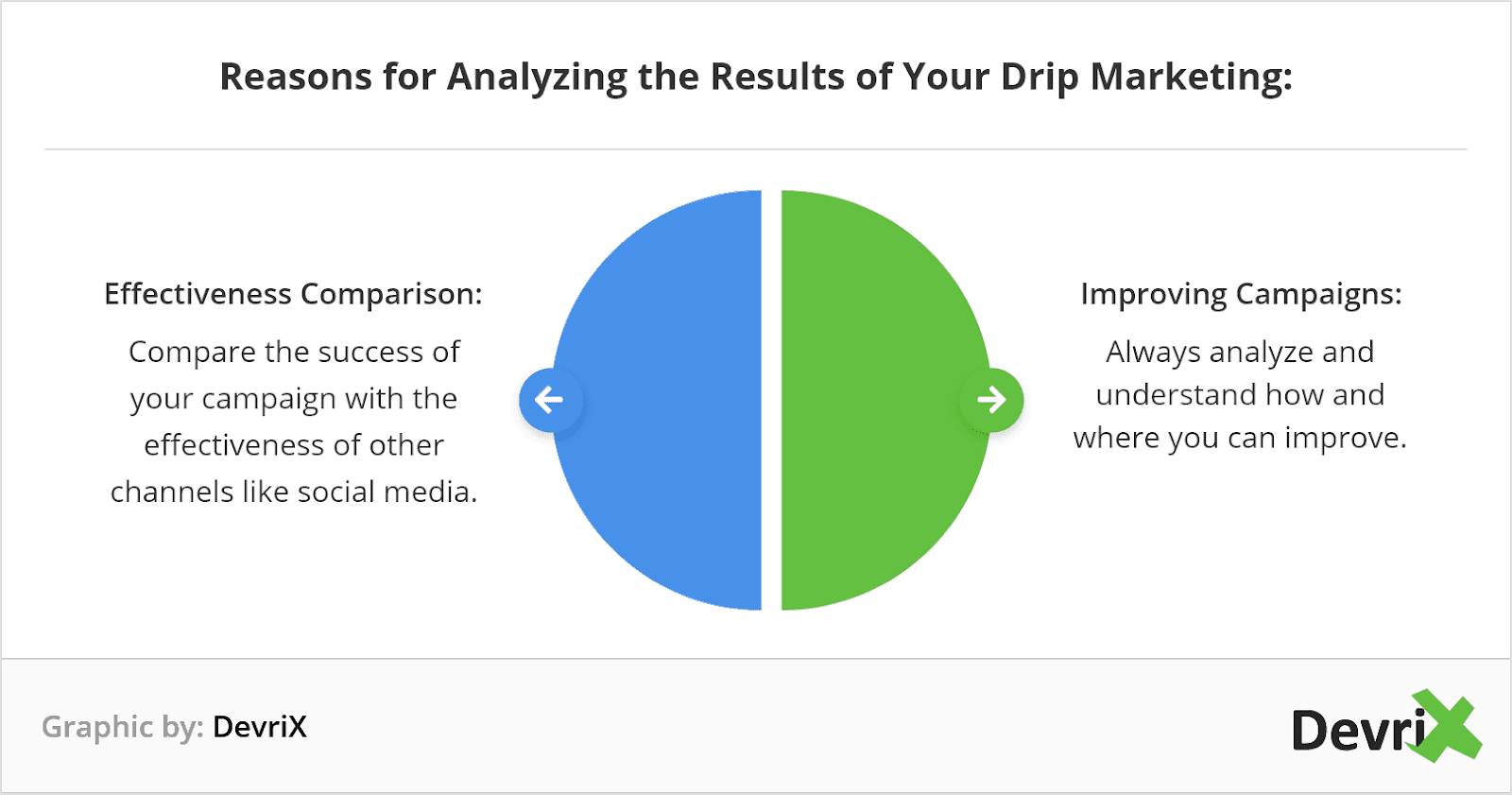
Drip marketing campaign installation is only the start. For success, you have to evaluate the effectiveness of your efforts and make necessary adjustments.
We'll proceed you through the necessary metrics for monitoring, along with the significance of A/B testing and iteration.
Key Metrics to Track
Monitoring important metrics that reveal information about the engagement and activities of your audience is essential to understanding the results of your drip campaigns.
You may use such data to assess the effectiveness of your emails and make informed decisions. Let's examine the important metrics to monitor:
Open Rates: The percentage of receivers who open your emails is measured by their open rates. A high open rate suggests that your pre-headers and subject lines are attention-grabbing enough.
Click-Through Rates (CTRs): The percentage of receivers that clicked on any link in your email is measured by click-through rates.
This indicator shows you how much interaction your emails are getting. A high click-through rate (CTR) suggests your material is interesting and motivates readers to act.
Examine CTRs to find out where your email's content and call-to-action buttons need improvement.
Conversion Rates: The percentage of receivers who effectively carry out the intended action—making a purchase, registering for an event, or downloading a resource—is measured by conversion rates.
Measuring conversion rates enables you to determine how well your attempts at email advertising are achieving their goals. Make adjustments to your email content and calls-to-action using this metric.
Unsubscribe Rates: Tracking unsubscribe rates is important for determining audience dissatisfaction even though it's discouraging to watch individuals unsubscribe from your emails.
To identify possible problems with your email targeting, frequency, or content, keep an eye on this measure.
Resolving the causes of high unsubscribe rates can help you in keeping a greater number of subscribers.
Suggested Reading:
Maximizing ROI with BotPenguin's Marketing Automation Chatbot
A/B Testing and Iteration
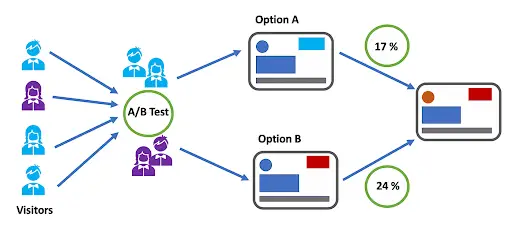
An essential strategy for drip marketing optimization is A/B testing. Using this technique, you test multiple versions of your emails to find the components that work best.
Let's explore how iteration and A/B testing may improve the success rate of your campaign:
Subject Lines and Pre-Headers: To improve email open rates, start by experimenting with alternative pre-headers and subject lines.
Test iterations that stimulate interest, provide a clear benefit, or create a feeling of urgency. You can refine your subject lines for optimal engagement and find the successful elements using A/B testing.
Content and Design: Try out several styles and content types to find what appeals to your audience the most. Experiment around with different email layouts, images, typefaces, and email lengths. Through experimentation with various configurations.
Call-to-Action Buttons: Increasing click-through and conversion rates requires improving your call-to-action (CTA) buttons.
To identify the most effective CTA, experiment with size, color, language, and location. To find the CTA that gets the most engagement and conversions, do A/B tests.
Timing and Frequency: Two essential elements of a good drip strategy are timing and frequency. Try out various email intervals and the best times to send them for the most interaction.
Try varying the frequency of your emails as well to determine the ideal balance between keeping readers interested and not boring them.
Iteration Based on Data: The key to efficiency is iteration. Examine the outcomes of your A/B testing and modify your drip campaign with data-driven decisions.
To continuously increase engagement and conversion rates, include the winning components in your upcoming emails.
You may improve the outcomes of your campaign over time by enhancing it based on data.
Conclusion
In conclusion, drip programs are a go-to tool in your marketing automation, if you want to significantly boost customer engagement, retention, and conversion rates.
You can connect with your audience by creating smart campaigns that include relevant content and customized messaging. The process doesn't end there, though; you must constantly examine, test, and adjust your projects in the context of data.
The main goal is to build long-lasting connections with your clients and keep them interested. Building strong relationships with your customers and keeping them continually engaged and invested in your business is still the main goal.
Even with research showing a 15% boost in conversion rates and a 20% increase in engagement after the implementation of drip programs. embrace the endless possibilities of drip campaigns and watch your marketing automation projects succeed!
Suggested Reading:
Marketing Automation for E-commerce: Tips and Tricks
Frequently Asked Questions (FAQs)
What are the differences between drip campaigns and traditional email marketing?
Unlike traditional email marketing, drip campaigns focus on delivering automated, personalized, and targeted content to nurture leads over time.
Meanwhile, traditional email marketing often involves one-time mass email blasts without considering individual customer interactions and behaviors.
What are the key benefits of integrating drip campaigns into marketing automation?
Drip campaigns can nurture leads, boost customer engagement, and increase conversions by delivering targeted and timely content, thereby fostering stronger customer relationships and driving overall marketing effectiveness.
How can one create an effective drip campaign strategy for customer retention?
Crafting a compelling content sequence, segmenting the audience based on behavior, and personalizing messaging are crucial steps in building a successful drip campaign that promotes customer retention and loyalty.
What role does personalization play in the success of drip campaigns?
Personalization is vital in drip campaigns as it helps deliver tailored content and relevant offers based on customer preferences and behaviors, leading to increased engagement and a higher likelihood of conversions.
How can drip campaigns be optimized for lead nurturing and conversion?
By delivering targeted content based on the customer's journey stage, employing A/B testing for email variations, and analyzing customer data to refine segmentation, marketers can optimize drip campaigns for effective lead nurturing and improved conversion rates.


